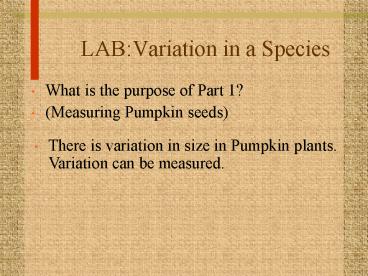LAB:Variation in a Species - PowerPoint PPT Presentation
1 / 13
Title:
LAB:Variation in a Species
Description:
LAB:Variation in a Species What is the purpose of Part 1? (Measuring Pumpkin seeds) There is variation in size in Pumpkin plants. Variation can be measured. – PowerPoint PPT presentation
Number of Views:168
Avg rating:3.0/5.0
Title: LAB:Variation in a Species
1
LABVariation in a Species
- What is the purpose of Part 1?
- (Measuring Pumpkin seeds)
- There is variation in size in Pumpkin plants.
Variation can be measured.
2
LABVariation in a Species
- What is the purpose of Part 2?
- (Calculate how long it takes pumpkin plants to
take over the Earth)
- There are reasons to explain why pumpkin plants
have not ever taken over the Earth
3
LABVariation in a Species
- What is the purpose of Part 3?
- (Effect of predators on sweet cute Bonitos)
- There are reasons to explain why the population
of bonitos on one island look different from
bonitos on another island
4
What is a species?
- A group of living things that
- are similar,
- and can breed together in nature
- to produce fertile offspring.
5
What is a population?
- A group of living things that
- belong to the same species,
- live in the same area,
- and can reproduce together.
6
What is a gene pool?
- The total collection of genes in a population at
any one time.
7
Hardy Weinberg
- What is allele frequency?
- 1908 Hardy and Weinberg invented the term
allele frequency to describe the percentage of
dominant and recessive alleles found in a
populaton.
8
Hardy Weinberg
- How is allele frequency measured?
- Example a lizard population might have the
following allele frequency for the alleles F and
f - FF 0.64 (64)
- Ff 0.32 (32)
- ff 0.04 (4)
9
Hardy Weinberg
- What is genetic equilibrium?
- 1908 Hardy and Weinberg invented the term
genetic equilibrium to describe a population in
which the frequency of alleles stays the same
from one generation to the next.
10
Hardy Weinberg
- How was genetic equilibrium measured?
- Hardy-Weinberg equations
- p2 2pq q2 1
- p q 1
11
Hardy Weinberg
- Hardy-Weinberg Equations
- Where p2 is the frequency of homozygous dominant
individuals
- Where 2pq is the frequency of heterozygous
individuals
- Where q2 is the frequency of homozygous recessive
individuals
12
Hardy Weinberg
- What causes genetic equilibrium?
- There must be.
- A large population
- Members mating at random
- No mutation
- No migration
- No natural selection
13
Hardy Weinberg
- What can cause allele frequency to change?
- Migration (also called gene flow)
- Mutation
- Mate selection (non-random mating)
- Predators, disease, famine, drought, storms,
accidents.

